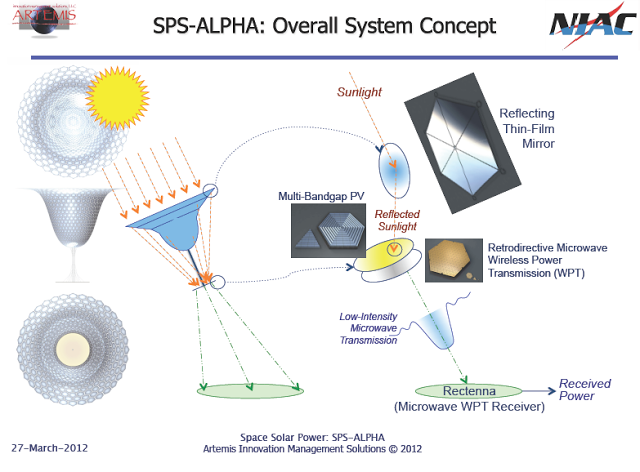Space.com – Last August, Artemis Innovation Management Solutions was selected for a NASA NIAC award to dive into the details of what Mankins labels “the first practical solar-power satellite concept.”
24 page presentation at the NIAC Spring Symposium
A preliminary draft of an estimated schedule would target getting a 1.2 gigawatt system up by 2024.
The project will be an energetic one-year study of the design. SPS-ALPHA is short for Solar Power Satellite via Arbitrarily Large PHased Array.
Along with reviewing the conceptual feasibility of the SPS-ALPHA, the team will carry out select proof-of-concept technology experiments.
SPS-ALPHA is a novel “biomimetic” approach to the challenge of space solar power, Mankins told SPACE.com.
Biomimetic refers to human-made processes, substances, devices or systems that imitate nature. The booming field of biomimetics is of interest to researchers in nanotechnology, robotics, artificial intelligence, the medical industry and the military.
Megawatts of power
If successful, Mankins said that this project would make possible the construction of huge platforms from tens of thousands of small elements that can deliver remotely and affordably tens to thousands of megawatts using wireless power transmission to markets on Earth, as well as missions in space, Mankins said.
SPS-ALPHA uses a large array of individually controlled thin-film mirrors, outfitted on the curved surface of the satellite. These movable mirrors intercept and redirect incoming sunlight toward photovoltaic cells affixed to the backside of the solar power satellite’s large array.
The Earth-pointing side of this large modular circular array is tiled with a collection of microwave-power transmission panels that generate the coherent, low-intensity beam of radio frequency energy and transmits that energy to Earth.
Mass production
According to Mankins, the SPS-ALPHA has several important advantages over past solar-power satellite approaches.
For example, this new approach eliminates the need for a large integrated power management and distribution system. That significantly reduces the projected cost of the platform, Mankins said during the NIAC gathering.
Moreover, the SPS-ALPHA concept, Mankins said, enables a solar-power satellite that can be assembled entirely from individual system elements that weigh no more than 110 to 440 pounds (50 to 200 kilograms), allowing all pieces to be mass produced at dramatically lower cost than traditional space systems. Therefore, a drastically reduced cost of the SPS system is realizable, he said.
“The current project will provide a detailed analytical understanding of the SPS-ALPHA concept, with supporting experiments,” Mankins said. “The needed next steps are to develop a working prototype of one or more of the modules and demonstrate the assembled system in the field. Over the next several years, the goal is to realize a low-Earth orbit flight test of the system,” he concluded.
If you liked this article, please give it a quick review on ycombinator or StumbleUpon. Thanks

Brian Wang is a Futurist Thought Leader and a popular Science blogger with 1 million readers per month. His blog Nextbigfuture.com is ranked #1 Science News Blog. It covers many disruptive technology and trends including Space, Robotics, Artificial Intelligence, Medicine, Anti-aging Biotechnology, and Nanotechnology.
Known for identifying cutting edge technologies, he is currently a Co-Founder of a startup and fundraiser for high potential early-stage companies. He is the Head of Research for Allocations for deep technology investments and an Angel Investor at Space Angels.
A frequent speaker at corporations, he has been a TEDx speaker, a Singularity University speaker and guest at numerous interviews for radio and podcasts. He is open to public speaking and advising engagements.








